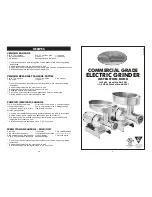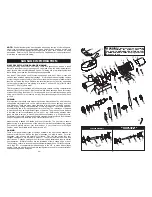
-6-
-19-
WARNING!
1.
DO NOT
use the
Grinder
without the
Tray
and the
Tray Guard
secured into place.
2.
ALWAYS DISCONNECT Grinder
from
power source before servicing, changing
accessories or cleaning the unit.
3. Plug the
Grinder
into a standard 120 Volt,
60 Hz wall outlet.
4.
DO NOT USE
the
Grinder
if the
Power
Cord, Plug
or any other parts are damaged. If
the
Power Cord
or the
Grinder
is damaged,
call Customer Service.
DO NOT ATTEMPT TO
REPLACE THE CORD.
Be sure to not allow
the
Power Cord
to drape into your work area.
Check that all parts are operating properly,
and perform the intended functions. Check
for alignment of moving parts or any other
conditions that may affect the operation.
5.
NEVER
use any accessories or parts from
other manufacturers. Doing so will VOID YOUR
WARRANTY and may cause fire, electrical
shock or injury.
6. TO PROTECT AGAINST RISK OF
ELECTRICAL SHOCK:
DO NOT
SUBMERGE
THE
MAIN GRINDER BODY
INTO WATER
OR LIQUID. BE SURE THE
GRINDER
IS
DISCONNECTED FROM THE POWER
SOURCE BEFORE CLEANING. Wash all
parts by hand and thoroughly dry. Thoroughly
clean all parts that will come in contact with
food before using the appliance.
NEVER
rinse
appliance
Grinder Motor
under tap, only use a
moist cloth to clean the
Grinder Motor Unit
.
7. Reduce risk of unintentional starting. Make
sure the
Power Switch
is in the “OFF” position
before attaching to the power source.
8.
KEEP FINGERS CLEAR
of the
Auger
and
Cutting Blades
AT ALL TIMES
.
NEVER
REACH INTO THE GRINDER
, doing so may
cause serious injury.
ALWAYS USE THE
PROVIDED STOMPER, NEVER FEED FOOD
BY HAND.
9.
NEVER
use fingers to scrape food away
from the
Grinding Plate
while the
Grinder
is in
operation.
SEVERE INJURY MAY RESULT.
10.
NEVER LEAVE THE GRINDER
UNATTENDED.
Be safe,
DISCONNECT
the
Grinder
from power source before leaving the
work area. Close supervision is necessary
when any appliance is used near children. This
appliance is
NOT
to be used by children.
11. Wait until all moving parts have stopped
before you remove any part of the
Grinder
, or
before switching the
Grinder
in reverse.
12.
TIE BACK
loose hair and clothing, and roll
up long sleeves before operating the Grinder.
REMOVE
ties, rings, watches, bracelets, or
other jewelry before operating the
Grinder
.
13. Be sure the
Grinder
is on a stable work
surface. Be sure all the
Grinder Feet
are
stable.
14.
DO NOT
attempt to grind bones, nuts or
other hard items.
15.
DO NOT
run
Grinder
without meat in the
Head
. Severe damage to the
Head
and
Auger
may occur.
16.
WEAR EYE PROTECTION.
Wear safety
glasses. Everyday eye glasses are not safety
glasses. Safety glasses conform to ANSI Z87.1
requirements. Note: approved safety glasses
have Z87 printed or stamped on them.
17.
DO NOT
use outdoors.
18.
DO NOT
use the
Grinder
while under the
influence of drugs, medications or alcohol.
19.
DO NOT
let the
Power Cord
hang over
edge of work surface.
20.
DO NOT
attempt to operate the
Grinder
if the
Grinder
itself is cold. The
Grinder
temperature should be at least 45
o
F (7
o
C)
before beginning.
21. The
Gear Housing
and the
Motor Cover
may become HOT during operation. This is
normal. DO NOT touch these parts during
operation or until they cool after use.
IMPORTANT SAFETY RULES
SAVE THESE INSTRUCTIONS!
Refer to them often and use them to instruct others.
READ AND FULLY UNDERSTAND ALL INSTRUCTIONS
AND WARNINGS PRIOR TO USING THIS UNIT. YOUR
SAFETY IS MOST IMPORTANT! FAILURE TO COMPLY
WITH PROCEDURES AND SAFEGUARDS MAY RESULT
IN SERIOUS INJURY OR PROPERTY DAMAGE.
REMEMBER: YOUR PERSONAL SAFETY IS YOUR
RESPONSIBILITY!
There are basic rules to follow when handling food.
They are
COOK, SEPARATE, CLEAN,
and
CHILL.
COOK
It’s crucial to cook food to a safe internal temperature to destroy bacteria that is
present. The safety of hamburgers and other foods made with ground meat has
been receiving a lot of attention lately, and with good reason. When meat is ground,
the bacteria present on the surface is mixed throughout the ground mixture. If this
ground meat is not cooked to at least 160
o
F to 165
o
F (71
o
C to 74
o
C), bacteria will not
be destroyed and there’s a good chance you will get sick.
Solid pieces of meat like steaks and chops don’t have dangerous bacteria like E.
coli on the inside, so they can be served more rare. Still, any beef cut should be
cooked to an internal temperature of at least 145
o
F (63
o
C) (medium rare). The safe
temperature for poultry is 180
o
F (82
o
C) and solid cuts of pork should be cooked to
160
o
F (71
o
C). Eggs should be thoroughly cooked too. If you are making a meringue
or other recipe that uses uncooked eggs, buy specially pasteurized eggs or use
prepared meringue powder.
SEPARATE
Foods that will be eaten uncooked and foods that will be cooked before eating MUST
ALWAYS be separated. Cross-contamination occurs when raw meats or eggs come
in contact with foods that will be eaten uncooked. This is a major source of food
poisoning. Always double-wrap raw meats and place them on the lowest shelf in the
refrigerator so there is no way juices can drip onto fresh produce. Then use the raw
meats within 1-2 days of purchase, or freeze for longer storage. Defrost frozen meats
in the refrigerator, not on the counter.
When grilling or cooking raw meats or fish, make sure to place the cooked meat on
a clean platter. Don’t use the same platter you used to carry the food out to the grill.
Wash the utensils used in grilling after the food is turned for the last time on the grill,
as well as spatulas and spoons used for stir-frying or turning meat as it cooks.
Make sure to wash your hands after handling raw meats or raw eggs. Washing hands
with soap and water, or using a pre-moistened antibacterial towelette is absolutely
necessary after you have touched raw meat or raw eggs. Not washing hands and
surfaces while cooking is a major cause of cross-contamination.
CLEAN
Wash your hands and work surfaces frequently when you are cooking. Washing with
soap and warm water for at least 15 seconds, then dry with a paper towel.
CHILL
Chilling food is very important. The danger zone where bacteria multiply is between
40
o
F and 140
o
F (4
o
C and 6
o
C). Your refrigerator should be set to 40
o
F (4
o
C) or below;
your freezer should be 0
o
F (-17
o
C) or below. Simple rule: serve hot foods hot, cold foods
cold. Use chafing dishes or hot plates to keep food hot while serving. Use ice water
baths to keep cold foods cold. Never let any food sit at room temperature for more than
2 hours - 1 hour if the ambient temperature is 90
o
F (32
o
C) or above. When packing
for a picnic, make sure the foods are already chilled when they go into the insulated
hamper. The hamper won’t chill food - it just keeps food cold when properly packed
with ice. Hot cooked foods should be placed in shallow containers and immediately
refrigerated so they cool rapidly. Make sure to cover foods after they are cool.
FOOD SAFETY












